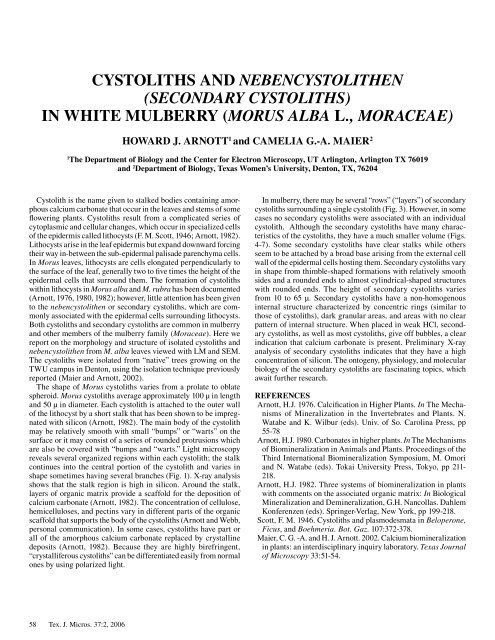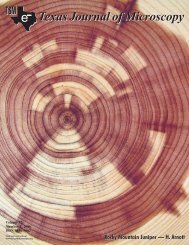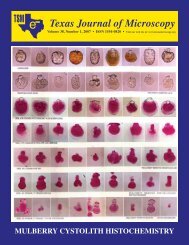Texas Journal of Microscopy - Texas Society for Microscopy
Texas Journal of Microscopy - Texas Society for Microscopy
Texas Journal of Microscopy - Texas Society for Microscopy
You also want an ePaper? Increase the reach of your titles
YUMPU automatically turns print PDFs into web optimized ePapers that Google loves.
CYSTOLITHS AND NEbENCYSTOLITHEN<br />
(SECONDARY CYSTOLITHS)<br />
IN WHITE MULBERRY (MORUS ALbA L., MORACEAE)<br />
Cystolith is the name given to stalked bodies containing amorphous<br />
calcium carbonate that occur in the leaves and stems <strong>of</strong> some<br />
flowering plants. Cystoliths result from a complicated series <strong>of</strong><br />
cytoplasmic and cellular changes, which occur in specialized cells<br />
<strong>of</strong> the epidermis called lithocysts (F. M. Scott, 1946; Arnott, 1982).<br />
Lithocysts arise in the leaf epidermis but expand downward <strong>for</strong>cing<br />
their way in-between the sub-epidermal palisade parenchyma cells.<br />
In Morus leaves, lithocysts are cells elongated perpendicularly to<br />
the surface <strong>of</strong> the leaf, generally two to five times the height <strong>of</strong> the<br />
epidermal cells that surround them. The <strong>for</strong>mation <strong>of</strong> cystoliths<br />
within lithocysts in Morus alba and M. rubra has been documented<br />
(Arnott, 1976, 1980, 1982); however, little attention has been given<br />
to the nebencystolithen or secondary cystoliths, which are commonly<br />
associated with the epidermal cells surrounding lithocysts.<br />
Both cystoliths and secondary cystoliths are common in mulberry<br />
and other members <strong>of</strong> the mulberry family (Moraceae). Here we<br />
report on the morphology and structure <strong>of</strong> isolated cystoliths and<br />
nebencystolithen from M. alba leaves viewed with LM and SEM.<br />
The cystoliths were isolated from “native” trees growing on the<br />
TWU campus in Denton, using the isolation technique previously<br />
reported (Maier and Arnott, 2002).<br />
The shape <strong>of</strong> Morus cystoliths varies from a prolate to oblate<br />
spheroid. Morus cystoliths average approximately 100 µ in length<br />
and 50 µ in diameter. Each cystolith is attached to the outer wall<br />
<strong>of</strong> the lithocyst by a short stalk that has been shown to be impregnated<br />
with silicon (Arnott, 1982). The main body <strong>of</strong> the cystolith<br />
may be relatively smooth with small “bumps” or “warts” on the<br />
surface or it may consist <strong>of</strong> a series <strong>of</strong> rounded protrusions which<br />
are also be covered with “bumps and “warts.” Light microscopy<br />
reveals several organized regions within each cystolith; the stalk<br />
continues into the central portion <strong>of</strong> the cystolith and varies in<br />
shape sometimes having several branches (Fig. 1). X-ray analysis<br />
shows that the stalk region is high in silicon. Around the stalk,<br />
layers <strong>of</strong> organic matrix provide a scaffold <strong>for</strong> the deposition <strong>of</strong><br />
calcium carbonate (Arnott, 1982). The concentration <strong>of</strong> cellulose,<br />
hemicelluloses, and pectins vary in different parts <strong>of</strong> the organic<br />
scaffold that supports the body <strong>of</strong> the cystoliths (Arnott and Webb,<br />
personal communication). In some cases, cystoliths have part or<br />
all <strong>of</strong> the amorphous calcium carbonate replaced by crystalline<br />
deposits (Arnott, 1982). Because they are highly birefringent,<br />
“crystalliferous cystoliths” can be differentiated easily from normal<br />
ones by using polarized light.<br />
58 Tex. J. Micros. 37:2, 2006<br />
HOWARD J. ARNOTT 1 and CAMELIA G.-A. MAIER 2<br />
1 The Department <strong>of</strong> Biology and the Center <strong>for</strong> Electron <strong>Microscopy</strong>, UT Arlington, Arlington TX 76019<br />
and 2 Department <strong>of</strong> Biology, <strong>Texas</strong> Women’s University, Denton, TX, 76204<br />
In mulberry, there may be several “rows” (“layers”) <strong>of</strong> secondary<br />
cystoliths surrounding a single cystolith (Fig. 3). However, in some<br />
cases no secondary cystoliths were associated with an individual<br />
cystolith. Although the secondary cystoliths have many characteristics<br />
<strong>of</strong> the cystoliths, they have a much smaller volume (Figs.<br />
4-7). Some secondary cystoliths have clear stalks while others<br />
seem to be attached by a broad base arising from the external cell<br />
wall <strong>of</strong> the epidermal cells hosting them. Secondary cystoliths vary<br />
in shape from thimble-shaped <strong>for</strong>mations with relatively smooth<br />
sides and a rounded ends to almost cylindrical-shaped structures<br />
with rounded ends. The height <strong>of</strong> secondary cystoliths varies<br />
from 10 to 65 µ. Secondary cystoliths have a non-homogenous<br />
internal structure characterized by concentric rings (similar to<br />
those <strong>of</strong> cystoliths), dark granular areas, and areas with no clear<br />
pattern <strong>of</strong> internal structure. When placed in weak HCl, secondary<br />
cystoliths, as well as most cystoliths, give <strong>of</strong>f bubbles, a clear<br />
indication that calcium carbonate is present. Preliminary X-ray<br />
analysis <strong>of</strong> secondary cystoliths indicates that they have a high<br />
concentration <strong>of</strong> silicon. The ontogeny, physiology, and molecular<br />
biology <strong>of</strong> the secondary cystoliths are fascinating topics, which<br />
await further research.<br />
REFERENCES<br />
Arnott, H.J. 1976. Calcification in Higher Plants. In The Mechanisms<br />
<strong>of</strong> Mineralization in the Invertebrates and Plants. N.<br />
Watabe and K. Wilbur (eds). Univ. <strong>of</strong> So. Carolina Press, pp<br />
55-78<br />
Arnott, H.J. 1980. Carbonates in higher plants. In The Mechanisms<br />
<strong>of</strong> Biomineralization in Animals and Plants. Proceedings <strong>of</strong> the<br />
Third International Biomineralization Symposium, M. Omori<br />
and N. Watabe (eds). Tokai University Press, Tokyo, pp 211-<br />
218.<br />
Arnott, H.J. 1982. Three systems <strong>of</strong> biomineralization in plants<br />
with comments on the associated organic matrix: In Biological<br />
Mineralization and Demineralization, G.H. Nancollas. Dahlem<br />
Konferenzen (eds). Springer-Verlag, New York, pp 199-218.<br />
Scott, F. M. 1946. Cystoliths and plasmodesmata in Beloperone,<br />
Ficus, and Boehmeria. Bot. Gaz. 107:372-378.<br />
Maier, C. G. -A. and H. J. Arnott. 2002. Calcium biomineralization<br />
in plants: an interdisciplinary inquiry laboratory. <strong>Texas</strong> <strong>Journal</strong><br />
<strong>of</strong> <strong>Microscopy</strong> 33:51-54.




